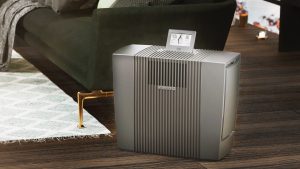Summer heat means you’re likely to close up your home and run the central air nonstop. The result can be a stuffy space that feels more like a trip to a tropical subclimate than a productive work environment. Poor home office air quality may be the culprit if you struggle to maintain focus and experience low energy levels.
Your AC’s Impact on Indoor Air Quality
While your AC unit will filter some particles out, it’s not an air purification method. Additionally, many areas experience increased humidity during the warmest season, which can facilitate mold growth. AC units can contribute to poor air quality by circulating dust or mold from the system. If your home is older or poorly ventilated, the problem could be more concerning and impact your health in multiple ways.
The Environmental Protection Agency notes that people spend 90% of their time inside, where pollutants are two to five times higher than outside. When the weather is milder, remote workers can move outdoors for part of the day and escape the stale inside air. However, when summer’s sweltering heat hits, they are more likely to work indoors the whole workday.
How to Get Cleaner Air
Awareness is the first step to improving how well you breathe while working at home. Here are the best ways to battle poor air quality in offices and breathe easier.
1. Get Outside
Although there are pollutants outdoors, indoor air quality is more potent. In addition to creating cleaner air in the home, taking a break every couple of hours and spending a few minutes outside has multiple health benefits, including absorbing some Vitamin D. Plus, adding some plants improves the nearby air quality and gives you some cooling shade.
Ample outdoor seating is crucial so you have a comfortable space to move your laptop outside or sit and make business calls. Consider elements such as where the sun hits at different times and how shade might create a clearer view of your digital screens.
2. Swap Your AC’s Filters
Regularly replacing filters on your heating and cooling systems will help filter pollutants better and help your machine perform at maximum efficiency. Although changing them takes only a few minutes, it’s a household task that’s easy to forget.
Set a reminder on your smartphone to change the filters monthly and possibly more frequently if you have many people and pets in the home. You can also order filters from a home improvement store and set them to auto-ship so you never run out.
3. Clean and Moisturize the Air

Air purifiers have their place, but if you want to deal with dry indoor air and pollutants simultaneously, an Airwasher may be a handy solution. Airwashers go beyond filtering the air by also humidifying and cleaning it via evaporative technology. They remove up to 99.97% of pollen and fine dust.
Working from home productively often includes endless meetings. If you find you grow hoarse from all the video conferences, a humidifier may be the answer to your concerns. Adding moisture to your home office can reduce respiratory irritation and dry eyes from staring at a blue light all day.
Airwashers work by drawing stale air into the unit via an intake system, which filters through both a coarse dust pre-filter and a HEPA filter. Simultaneously, the air moves over a stack of rotating plates that collect water to evaporate into your space, offering humidification advantages.
A natural cleaning method keeps your home from becoming oversaturated. Look for an Airwasher that works without heat or mist. Ideally, the comfort level will be consistent without the humidifier side effects that lead to mold or mildew. The right machine does the heavy lifting to ensure everything runs smoothly, giving you the best possible air quality.
4. Use Plants to Level H2O and CO2

Adding greenery gives your home work area beauty and filters carbon monoxide while increasing oxygen levels in the room. Some plants are better as natural air filters. Although company leaders post anecdotal evidence in forums about plants relating to worker productivity in health, the last available research study was in 2015 by Human Spaces, where researchers found that those with natural elements in their workspace had 15% higher well-being and creativity.
Another 2015 study from Harvard University experimented with indoor environmental quality. It researched the behaviors of 24 workers working in various green building conditions, which had low amounts of volatile organic compounds. One simulated the feeling of being outdoors with increased ventilation, and the other had artificially higher CO2 that would come from plants. Subjects had 61% and 101% higher cognitive abilities in each scenario, respectively.
Remote work productivity statistics are often broad and fail to pinpoint the exact efforts that lead to better results. The productivity improvements could be due to slightly cleaner air, increased oxygen, or creating a homier feel.
More research is necessary to determine the exact correlation between plants and productivity. For now, adding a few to your space is worth trying.
5. Improve Ventilation
How to improve air quality in an office can be as simple as opening a window to let sunlight filter in and create a cross-breeze through your house. Research shows that greater ventilation prevents many respiratory ailments, like asthma and sick building syndrome. Lowering risk by opening windows lets natural light in, lowering stress and boosting alertness while working. These benefits could lead to fewer sick days, better employee morale, as well as breathing easier and having better focus.
Ensuring proper ventilation also reduces indoor carbon dioxide and volatile organic compounds from cleaning products. Set a daily reminder on your calendar to open the windows and turn on a fan.
Measuring the Results of Cleaner Air
You may be uncertain if you should invest in air cleaning systems or office plants. While it’s impossible to measure the impact of higher air quality in your home office fully, the benefits tap into common sense.
Homeowners throw open the windows in the spring to clear the old air and make way for the new. Many of the routines people have practiced for centuries can work alongside modern technology to improve the air in your office, boost mood and increase productivity levels. This summer, look for small ways to create clean air rituals. Start with small changes like better ventilation and a few plants so you can breathe and work smarter.

